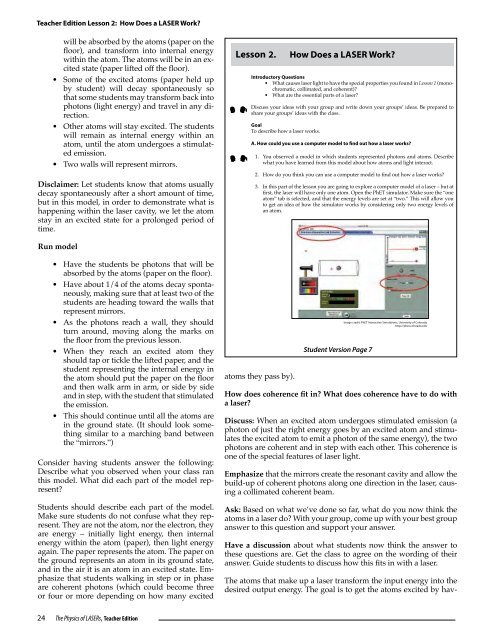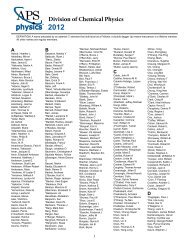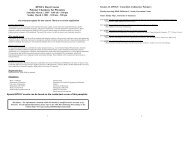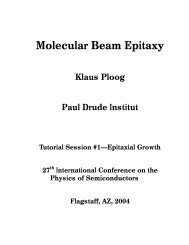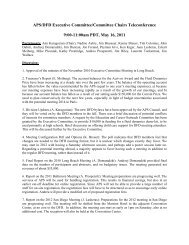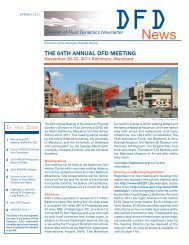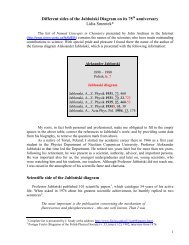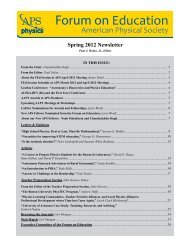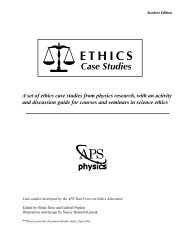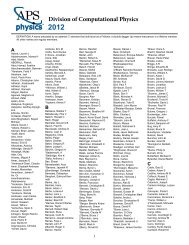The Physics of LASERs - American Physical Society
The Physics of LASERs - American Physical Society
The Physics of LASERs - American Physical Society
Create successful ePaper yourself
Turn your PDF publications into a flip-book with our unique Google optimized e-Paper software.
Teacher Edition Lesson 2: How Does a LASER Work?<br />
24<br />
will be absorbed by the atoms (paper on the<br />
floor), and transform into internal energy<br />
within the atom. <strong>The</strong> atoms will be in an excited<br />
state (paper lifted <strong>of</strong>f the floor).<br />
• Some <strong>of</strong> the excited atoms (paper held up<br />
by student) will decay spontaneously so<br />
that some students may transform back into<br />
photons (light energy) and travel in any direction.<br />
• Other atoms will stay excited. <strong>The</strong> students<br />
will remain as internal energy within an<br />
atom, until the atom undergoes a stimulated<br />
emission.<br />
• Two walls will represent mirrors.<br />
Disclaimer: Let students know that atoms usually<br />
decay spontaneously after a short amount <strong>of</strong> time,<br />
but in this model, in order to demonstrate what is<br />
happening within the laser cavity, we let the atom<br />
stay in an excited state for a prolonged period <strong>of</strong><br />
time.<br />
Run model<br />
• Have the students be photons that will be<br />
absorbed by the atoms (paper on the floor).<br />
• Have about 1/4 <strong>of</strong> the atoms decay spontaneously,<br />
making sure that at least two <strong>of</strong> the<br />
students are heading toward the walls that<br />
represent mirrors.<br />
• As the photons reach a wall, they should<br />
turn around, moving along the marks on<br />
the floor from the previous lesson.<br />
• When they reach an excited atom they<br />
should tap or tickle the lifted paper, and the<br />
student representing the internal energy in<br />
the atom should put the paper on the floor<br />
and then walk arm in arm, or side by side<br />
and in step, with the student that stimulated<br />
the emission.<br />
• This should continue until all the atoms are<br />
in the ground state. (It should look something<br />
similar to a marching band between<br />
the “mirrors.”)<br />
Consider having students answer the following:<br />
Describe what you observed when your class ran<br />
this model. What did each part <strong>of</strong> the model represent?<br />
Students should describe each part <strong>of</strong> the model.<br />
Make sure students do not confuse what they represent.<br />
<strong>The</strong>y are not the atom, nor the electron, they<br />
are energy – initially light energy, then internal<br />
energy within the atom (paper), then light energy<br />
again. <strong>The</strong> paper represents the atom. <strong>The</strong> paper on<br />
the ground represents an atom in its ground state,<br />
and in the air it is an atom in an excited state. Emphasize<br />
that students walking in step or in phase<br />
are coherent photons (which could become three<br />
or four or more depending on how many excited<br />
<strong>The</strong> <strong>Physics</strong> <strong>of</strong> <strong>LASERs</strong>, Teacher Edition<br />
Lesson 2.<br />
atoms they pass by).<br />
Student Edition Lesson 2: How Does a LASER Work?<br />
Introductory Questions<br />
• What causes laser light to have the special properties you found in Lesson 1 (monochromatic,<br />
collimated, and coherent)?<br />
• What are the essential parts <strong>of</strong> a laser?<br />
Discuss your ideas with your group and write down your groups’ ideas. Be prepared to<br />
share your groups’ ideas with the class.<br />
Goal<br />
To describe how a laser works.<br />
How Does a LASER Work?<br />
A. How could you use a computer model to find out how a laser works?<br />
1. You observed a model in which students represented photons and atoms. Describe<br />
what you have learned from this model about how atoms and light interact.<br />
2. How do you think you can use a computer model to find out how a laser works?<br />
3. In this part <strong>of</strong> the lesson you are going to explore a computer model <strong>of</strong> a laser – but at<br />
first, the laser will have only one atom. Open the PhET simulator. Make sure the “one<br />
atom” tab is selected, and that the energy levels are set at “two.” This will allow you<br />
to get an idea <strong>of</strong> how the simulator works by considering only two energy levels <strong>of</strong><br />
an atom.<br />
Student Version Page 7<br />
Image credit: PhET Interactive Simulations, University <strong>of</strong> Colorado<br />
http://phet.colorado.edu<br />
<strong>The</strong> <strong>Physics</strong> <strong>of</strong> <strong>LASERs</strong> 7<br />
How does coherence fit in? What does coherence have to do with<br />
a laser?<br />
Discuss: When an excited atom undergoes stimulated emission (a<br />
photon <strong>of</strong> just the right energy goes by an excited atom and stimulates<br />
the excited atom to emit a photon <strong>of</strong> the same energy), the two<br />
photons are coherent and in step with each other. This coherence is<br />
one <strong>of</strong> the special features <strong>of</strong> laser light.<br />
Emphasize that the mirrors create the resonant cavity and allow the<br />
build-up <strong>of</strong> coherent photons along one direction in the laser, causing<br />
a collimated coherent beam.<br />
Ask: Based on what we’ve done so far, what do you now think the<br />
atoms in a laser do? With your group, come up with your best group<br />
answer to this question and support your answer.<br />
Have a discussion about what students now think the answer to<br />
these questions are. Get the class to agree on the wording <strong>of</strong> their<br />
answer. Guide students to discuss how this fits in with a laser.<br />
<strong>The</strong> atoms that make up a laser transform the input energy into the<br />
desired output energy. <strong>The</strong> goal is to get the atoms excited by hav-


